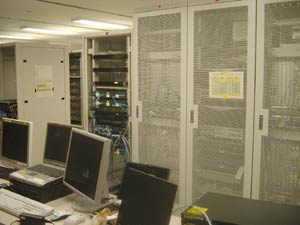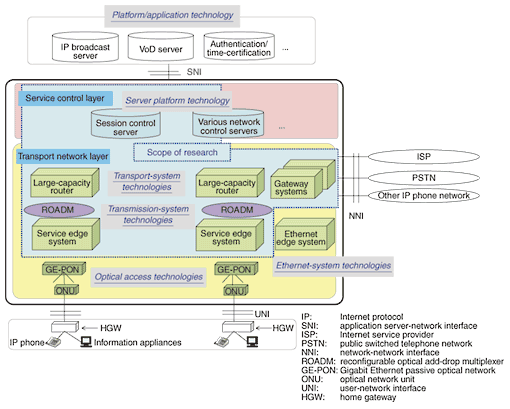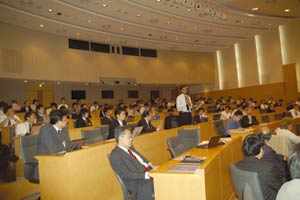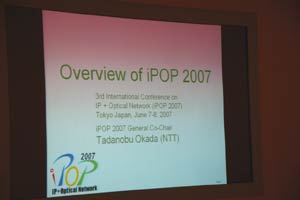 |
|
|
|
|
|
Spotlight on NTT Laboratories Vol. 5, No. 8, pp. 1–4, Aug. 2007. https://doi.org/10.53829/ntr200708lab  At the Forefront of NGN Research and Practical ApplicationAbstractThis month, we profile NTT Network Service Systems Laboratories, which makes its home at the Musashino R&D Center. These laboratories research and development core networks with a focus on the Next Generation Network (NGN). We talked with General Manager Koichi Seino to learn about front-line NGN research and the future outlook for the NGN. Establishing a foundation for the NGN–What is the role of Network Service Systems Laboratories in NTT? Network Service Systems Laboratories, which is based in the Musashino R&D Center (Photos 1 and 2), belongs to the NTT Information Sharing Laboratory Group. In a broad sense, our research covers all network-related fields, but our focus is on the core segment of the network including interconnectivity and transport within the core network. As part of this work, Network Service Systems Laboratories interfaces with other laboratories within the Information Sharing Laboratory Group as well as with the Cyber Communications Laboratory Group and the Science and Core Technology Laboratory Group.
–To make sure we understand the NGN correctly, please tell us exactly what kind of network it is and what NTT is doing to achieve it. The NGN is one research field that NTT is devoting much energy to (see Fig. 1). In a few words, it is a network that excels in quality, flexibility, security, reliability, and stability.
NGN technologies will enable the stable use of a wide array of services such as HDTV (high-definition television) video communication services and home-security, care-giving, and intelligent-surveillance services using information appliances. And NGN security technologies such as those for preventing unauthorized access will enable these services to be used with confidence. The NGN will provide users with high-value communication services. To provide these services, Network Service Systems Laboratories is researching and applying network-services control technology, next-generation link-system and router-configuration technologies, and core-network configuration technology, which are fundamental components of NGN core technology. In terms of research, we are concentrating our efforts in three areas. First, we are working to set up platforms for creating services. Second, we are researching all-optical transport technology and switching technology. And third, we are establishing operation methods in conjunction with those technologies and mechanisms for ensuring stability. Here, we are researching fundamental principles and performing ongoing feasibility studies inside the laboratories. At the same time, we are researching ways of achieving a successful migration to the NGN taking into consideration the aging facilities in the fixed telephone network. In the area of platform technology for creating services, we are researching and developing platforms to provide users with new services and with services that link to Internet applications. Collaboration with other operators including Internet service providers (ISPs) and application service providers (ASPs) will play an important part in providing these services. We are establishing technologies that will help make the development and provision of such collaborative services more efficient and flexible. We conduct feasibility tests of the fundamental principles used in system development. This testing is centered on optical technologies such as wavelength multiplexing and switching and on IP-optical transport technology for performing multilayer control and operations linked with IP (Internet protocol) technology. The aim of this IP-optical technology is to improve flexibility in the face of traffic fluctuations and to construct and provide high-reliability networks that will be robust against system faults and natural disasters. It can't be denied that the Internet in its present form is somewhat weak in the areas of security and reliability. The NGN is envisioned to be a technology for solving problems such as these that the Internet is experiencing. In actuality, research is proceeding on a number of elemental technologies with the aim of contributing to the practical application of the NGN. To this end, we are researching and developing network architectures that combine optical network technology, IP network technology, and technologies that support those architectures. We can also envision these research efforts being applied in a successive manner to the NGN, though the NGN itself has already entered an application phase. NTT is now conducting field trials of NGN services. These began in December 2006 and are scheduled to run for about one year. The plan is to commercialize those services at a later date on the basis of trial results. For the part of the network that governs these network services, Network Service Systems Laboratories is working out a data-transport system using IP technology and protocol for controlling the communications of an indeterminate number of users. This system and protocol will be used as a basis for developing communication-control systems with the aim of contributing to NTT business. NGN key issues: improving cost efficiency, stability, and reliability–It appears that the NGN has a role in establishing and enhancing NTT's competitive strength and financial foundation while also being a core technology in raising the company's international competitiveness. With this in mind, what do you see as key issues surrounding the NGN? NTT has declared that it will guarantee network quality when providing audio, video, and data services on an NGN infrastructure. But when providing high-quality services, it is not necessarily easy to strike a balance in terms of cost-benefit performance. NTT has been building telephone networks from the start, but the spread of the Internet has resulted in a dramatic increase in the number of users. Our intention is to take the best of both systems and provide new and novel services. The worlds of the Internet and the telephone have different protocols, however, and they must be made to interact smoothly through the use of high-quality, high-reliability technologies. Of course, this will require that the performance of the system itself be improved and that end-to-end quality from the network entry point to exit point be guaranteed. The occurrence of faults must also be dealt with by using other routers on the network so that no packet loss occurs and voice or data signals arrive at the target user without a hitch. For these reasons, we must resolve technical issues involved with quality and reliability, but how to do that in a cost-efficient manner presents some difficulties. –A major outage occurred not long ago with IP and Hikari (optical) phone services. The NGN network must be designed so as to prevent an outage of the type that occurred in the existing system. Current technical problems must be clarified and used as feedback in NGN design. These problems must be divided into network-architecture-related problems and system-related problems. In terms of network architecture, we must come up with a mechanism for distributing risk throughout the network and a mechanism for bypassing accidents like disconnections due to earthquakes or other disasters to ensure that the network keeps running. In the NGN, finding ways to handle such problems is an absolute necessity. Network Service Systems Laboratories is working to clarify these technical problems and is studying the appropriate timing for implementing the NGN. Outlook for NGN commercialization–What can you tell us about the medium- and long-term plans for the NGN? The first step toward the initial implementation of the NGN is the holding of field trials with concerned companies. As I mentioned, this began in 2006. The results of these trials can then be used as a basis for launching commercial services. Achieving 30 million optical-network subscribers by 2010 is an NTT target. These steps are the "opening moves" in the full-scale expansion of the NGN, and our plan is to keep moving forward while making appropriate course corrections as needed. An important element of the NGN will be the ability to provide diverse content and services using audio, data, and video media via the network. When talking about the NGN, the bare minimum, I believe, is interconnectivity with the Internet. But, as an engineering group, we are constantly performing technical studies on the direction of the NGN, giving due consideration to practical application and the ability to react flexibly to needs, while also thinking about the effects of new technology in terms of convenience and ease of use for the user and corporate benefits for NTT. "iPOP2007" held at Musashino R&D Center"iPOP2007," an international conference focusing on IP and optical networks, was held at the NTT Musashino R&D Center on June 7 and 8, 2007 (Photo 3). This was the third meeting for iPOP, which is sponsored by Photonic Internet Lab (PIL) and ISOCORE with the aim of promoting IP and optical networking technologies and internetworking. NTT, domestic vendors, telecommunications operators, and the academic community participate annually in the organizing and holding of iPOP. Up to now, the IP network and optical network have been operated independently. Linking the two and enabling internetworking will require international standardization activities and connectivity experiments in cooperation with many vendors using routers and an assortment of network devices. To this end, iPOP enables its organizing companies and overseas companies to meet in one place and present exhibits and new technologies in a cooperative spirit (Photo 4). Network Service Systems Laboratories plans to participate actively in such international communities and to share technology and know-how with concerned parties with the aim of establishing international standards and promoting internetworking.
|
|












